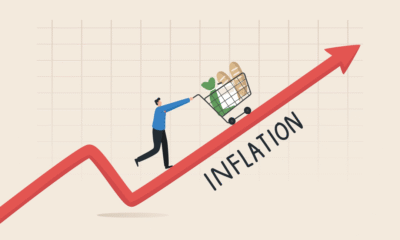Economics
OECD Downgrades UK Growth Forecast: What It Means for the Economy

Introduction to OECD and Its Role
The Organization for Economic Co-operation and Development (OECD) is an international organization founded in 1961, comprising 38 member countries, primarily from Europe, North America, and the Asia-Pacific region. Its primary purpose is to promote policies that improve the economic and social well-being of people worldwide. The OECD achieves this through rigorous economic research, data collection, and by providing a platform for governments to collaborate, share best practices, and coordinate economic policies.
The OECD plays a significant role in global economic assessments by consistently analyzing economic trends and providing forecasts that help shape policy decisions in its member countries. By evaluating key economic indicators such as GDP growth, inflation rates, and employment data, the OECD generates a comprehensive overview of current and future economic conditions. This information is invaluable as it guides policymakers in addressing various economic challenges, thereby reinforcing the credibility of the OECD’s recommendations.
The OECD’s analyses are driven by a commitment to evidence-based practices, which adds intrinsic value to its reports. It not only offers forecasts concerning economic growth but also advises on a range of issues, including education, health, and environmental sustainability. The organization issues periodic economic outlooks, providing member countries with critical insights that reflect both short-term and long-term economic trends. Consequently, the reports serve as essential resources for policymakers, businesses, and researchers aiming to understand the global economic landscape better.
By fostering dialogue and collaboration among its member countries, the OECD reinforces its status as a credible authority in economic matters. As a hub for sharing data and strategies, it ensures that its analyses influence economic governance at national and international levels, thereby enhancing the overall integrity of global economic policy-making.
Overview of the Downgrade
The recent downgrade of the United Kingdom’s growth forecast by the Organisation for Economic Co-operation and Development (OECD) has raised significant concerns regarding the future economic landscape. The OECD has revised its growth projections for the UK to 0.3% for the year 2023, down from a previous estimate of 0.5%. This adjustment highlights a weakening economic outlook that reflects existing challenges within the UK economy. Furthermore, the OECD’s projections for 2024 have also been reduced, indicating a more subdued recovery trajectory than earlier anticipated.
In addition to the updated growth rates, the OECD report underscores a variety of factors contributing to this downgrade. Inflationary pressures remain a primary concern, with rising living costs impacting consumer spending and overall economic activity. The global economic environment, particularly the ongoing ramifications of international conflicts and supply chain disruptions, has further exacerbated the situation, ultimately leading to diminished confidence among businesses and consumers alike.
This downgrade comes at a critical juncture, particularly following the UK’s recent attempts to stabilize its economy in the wake of the COVID-19 pandemic and Brexit. Historical comparisons reveal a stark decline in growth forecasts; prior to this recent downgrade, several projections anticipated a stronger economic rebound bolstered by consumer activity and public investment. The mismatch between anticipated and actual economic performance raises questions about the effectiveness of current economic policies and their ability to foster sustainable growth moving forward.
The timing of the OECD’s downgrade is particularly noteworthy, occurring just before key economic policy reviews and government budgets, which may have ramifications for policy direction and implementation strategies. As stakeholders analyze this downgrade, it is critical to consider how these revised growth forecasts will impact various sectors across the UK economy and the potential responses needed to address these emerging challenges.
Factors Leading to the Downgrade
The recent downgrade of the UK’s economic growth forecast by the OECD can be attributed to a multitude of interrelated factors. Among these, inflation rates have surged significantly, influenced by both global supply chain disruptions and domestic policy decisions. High inflation hampers consumer purchasing power, which directly affects demand for goods and services. This decreased demand can lead businesses to scale back investment and hiring, consequently slowing down economic growth.
Another pivotal factor contributing to the revised forecast is the adjustment of interest rates by the Bank of England. In a bid to curb inflation, the central bank has raised interest rates, which, while necessary, can also make borrowing more expensive for households and businesses. This tightening of monetary policy may deter consumer spending and business investment, ultimately impacting overall economic performance.
Geopolitical tensions, particularly surrounding trade agreements and regional conflicts, have also played a significant role in undermining economic stability. The uncertainty stemming from these tensions can lead to reduced investor confidence, thereby stifling foreign direct investment in the UK. Furthermore, the ongoing conflict in Ukraine and its repercussions on energy prices have exacerbated financial pressures within the economy.
Labor market conditions cannot be overlooked in this analysis. The UK has faced a tight labor market, compounded by skilled labor shortages in key industries. This scenario can hinder productivity growth as businesses grapple with staffing challenges. Additionally, the post-Brexit environment presents its own set of complications, including new trade barriers and regulatory requirements that continue to affect trade flows and economic relations with the EU.
In summary, the confluence of escalating inflation, elevated interest rates, geopolitical tensions, labor market dynamics, and the lingering effects of Brexit has created a precarious economic landscape. Each of these factors intricately links to the others, collectively prompting the OECD to reevaluate and downgrade the UK’s economic growth outlook.
Impacts on Business Confidence
The recent downgrade of the UK’s growth forecast by the OECD has raised significant concerns regarding business confidence across various sectors. As economic outlooks often shape decision-making processes, this downgrade may lead to immediate repercussions for businesses operating in the UK. Companies may react by reassessing their investment strategies, delaying capital expenditures, or even implementing hiring freezes to mitigate risks associated with an uncertain economic landscape.
When companies lack confidence in the economy’s future prospects, they are less likely to engage in ambitious growth initiatives. Instead, organizations may prioritize maintaining cash reserves in anticipation of potential downturns. This cautious approach can hinder business expansion, stifle innovation, and ultimately slow down economic activity. Capital investment decisions that would ordinarily contribute to productivity gains may be stalled, as firms adopt a wait-and-see stance. Moreover, this environment could lead to reduced consumer spending, further compounding the strain on businesses’ growth potential.
Long-term implications of this downgrade on business sentiment are also concerning. A trend of declining confidence may foster a cycle of pessimism, leading to a culture of risk aversion. This could discourage entrepreneurial ventures and deter foreign investments, as international firms weigh the UK’s economic viability against more stable markets. Over time, a lack of confidence may contribute to an erosion of the UK’s competitive edge, negatively impacting productivity and economic stability.
In conclusion, the OECD’s downgrade is likely to influence business confidence in multifaceted ways, affecting both immediate operational decisions and long-term growth prospects. The resultant shifts in investment strategies and business sentiments could bear substantial consequences for the UK economy as a whole.
Repercussions for Consumers
The recent downgrade of the UK growth forecast by the OECD has significant implications for consumers across the nation. As economic growth projections alter, consumer behavior is expected to shift as well, leading to potential changes in spending, confidence, and overall purchasing power. A decline in consumer confidence can emerge from uncertainties surrounding job security, wage growth, and inflationary pressures, prompting individuals to tighten their budgets.
One of the primary repercussions of this downgrade is the potential increase in inflation, which affects the cost of goods and services. As prices rise, consumer purchasing power diminishes, thereby making it more challenging for households to maintain their standard of living. For instance, data shows that inflation rates have been volatile, influencing essential items such as food and fuel, which are crucial components of household budgets. As the cost of these necessities escalates, discretionary spending may encounter significant cutbacks, impacting industries reliant on consumer expenditure.
Moreover, the downgrade can lead to an atmosphere of uncertainty, causing consumers to adopt a more cautious approach to their finances. A survey conducted by various market research firms indicates that many consumers are beginning to prioritize savings over spending, reflecting an inclination to prepare for potential economic difficulties. This shift is indicative of a broader trend where consumers are increasingly aware of their economic environment and its inherent risks, leading them to adjust their spending habits accordingly.
Additionally, local businesses may experience a decline in sales as consumers become more selective with their purchasing decisions. The ripple effect could disrupt the overall economic landscape, consequently reducing revenue streams for various sectors. Understanding the intricacies of these changes is crucial as consumers navigate this period of uncertainty, signalling a need for strategic financial planning moving forward.
Government Response and Policy Implications
In light of the OECD’s recent downgrade of the UK’s growth forecast, the government is likely to consider a range of strategic responses aimed at countering the anticipated economic challenges. Fundamental to this response is the implementation of fiscal policies that may include increased government spending on infrastructure projects and social programs. Such initiatives have historically played a critical role in stimulating demand and creating jobs, which are essential for bolstering the economy in times of sluggish growth.
Furthermore, the UK government may explore adjusting monetary policies to facilitate a more conducive environment for investment and consumer spending. This could involve the Bank of England reducing interest rates or engaging in quantitative easing. Lower interest rates can diminish borrowing costs for businesses and consumers, thereby encouraging spending and investment. However, the effectiveness of these monetary measures often hinges on the existing economic landscape and public confidence, which can significantly impact consumer behavior.
Another potential area of government intervention could be the introduction of targeted social programs, particularly aimed at supporting the most vulnerable populations during economic downturns. Programs that provide financial assistance or retraining opportunities could help mitigate the adverse social impacts of reduced growth. Nevertheless, implementing such programs necessitates a careful balance of budgetary constraints and political considerations. Additionally, the government needs to be cognizant of the long-term implications of increased public debt, which may constrain future fiscal flexibility.
The balancing act of stimulating growth while ensuring fiscal responsibility will present challenges for policymakers. As the UK navigates this uncertain economic environment, it is essential for the government to adopt a multifaceted approach that not only addresses immediate concerns but also lays the groundwork for sustainable growth. To this end, a collaborative effort amongst various sectors will be critical in fostering resilience within the economy.
Analysis of Global Economic Context
The recent downgrade of the UK’s growth forecast by the Organisation for Economic Co-operation and Development (OECD) has not emerged in isolation. Instead, it reflects a wider global economic landscape characterized by numerous challenges. Across various nations, economic indicators reveal that growth is generally slowing due to a combination of factors, including persistent supply chain disruptions, high energy prices, and geopolitical tensions.
Many countries, especially those heavily reliant on global trade, have faced substantial setbacks. For instance, the lingering effects of the COVID-19 pandemic continue to reverberate, as nations grapple with managing their economic recovery while contending with new variants and public health measures. These developments have hindered the smooth function of supply chains, leading to shortages and increased costs, which further complicate the economic recovery process. The UK’s experience, in this context, is emblematic of a broader trend observed in several advanced economies, where growth rates have not met earlier projections.
Furthermore, fluctuations in energy prices are of particular concern. The ongoing conflict in certain regions has exacerbated the volatility in energy markets, impacting both household and industrial consumption. These rising costs can act as a drag on economic activity, thereby contributing to the OECD’s negative growth outlook for the UK. The interconnectivity of today’s economies means that turmoil in one area can create ripple effects, affecting others; hence, the UK’s economic health cannot be analyzed in a vacuum.
In this volatile environment, the UK’s economic position appears precarious as it navigates global uncertainties. Understanding how these international dynamics impact local conditions is crucial for comprehending the nuances behind the OECD’s recent growth forecast downgrade. It highlights the interdependency of countries and the collective challenges they face in moving towards recovery.
Future Economic Outlook
The recent downgrade of the UK’s growth forecast by the OECD has significant implications for both the short-term and long-term economic landscape. In the short term, the anticipated slowdown could be exacerbated by several factors, including rising inflation rates, increasing cost of living, and potential disruptions in supply chains. These issues are likely to impact consumer spending and business investments, which are vital for stimulating economic growth. As households grapple with tightening budgets, discretionary spending may decline, leading to further contractions in economic activity.
Looking toward the long term, the outlook becomes increasingly complex. While some economists suggest that continued investments in technology and infrastructure could provide a pathway for recovery, challenges such as geopolitical tensions, trade relations, and labor market dynamics may hinder progress. The UK government has a crucial role in implementing policies that could enhance productivity and innovation. An emphasis on education and skills development would be necessary to prepare the workforce for an evolving job market, ensuring that the economy can adapt to future demands.
Encouragingly, certain sectors, such as green energy and digital technology, are poised for growth. The transition toward a more sustainable economy may create new opportunities and jobs, bolstering overall economic resilience. Additionally, international trade agreements post-Brexit may offer avenues for expansion in emerging markets, which could serve as a counterbalance to domestic economic challenges.
In conclusion, the future economic outlook for the UK is fraught with uncertainty. While the OECD’s downgrade signals potential struggles ahead, there are also opportunities for recovery through strategic investments and policy measures. Balancing short-term challenges with long-term strategies will be essential for navigating the evolving economic landscape.
Conclusion: Navigating the Economic Landscape
The recent downgrade of the UK’s growth forecast by the OECD has significant implications for a variety of stakeholders, including policymakers, business leaders, and the general public. This change in forecast is a reflection of the broader economic challenges currently facing the country, including factors like inflation, rising interest rates, and global economic uncertainties. Stakeholders must understand that such adjustments not only affect macroeconomic indicators but also influence personal and professional dynamics in profound ways.
For businesses, such forecasts serve as a crucial reminder to reassess strategic plans and operational efficiencies. Adapting to an evolving economic climate may mean re-evaluating investments or reconsidering workforce planning to maintain resilience. Innovation and flexibility could be the key drivers that enable businesses to navigate through challenging times. Furthermore, maintaining an awareness of economic trends is imperative for organizations, as it allows them to anticipate changes in consumer behavior and adjust their offerings accordingly.
Governments, on the other hand, may need to reassess fiscal policies and public spending priorities to stimulate growth and support vulnerable businesses and households. Effective communication regarding economic strategies will be essential to build public trust and ensure that citizens are prepared for potential impacts on their daily lives. Stakeholders should engage in informed discussions to understand how changes in economic forecasts can affect personal finances, investments, and societal wellbeing.
Ultimately, the OECD’s downgrade serves as a catalyst for reflection and a call to action. By staying informed about economic developments and adapting their strategies, individuals and organizations alike can better navigate the uncertainties ahead. Engaging with reliable economic updates can empower stakeholders to make prudent decisions that align with the shifting economic landscape.
Finance & Investment
Trade Surveillance in Banking: Lessons from JPMorgan’s $348 Million Fine

Trade surveillance is a critical compliance function in banking and financial services that ensures the integrity of market activities and adherence to regulatory requirements. Effective trade monitoring helps prevent market abuses such as insider trading, front-running, and manipulation, protecting both investors and the broader financial system. Recently, JPMorgan Chase faced a substantial $348 million fine imposed by the Federal Reserve and the Office of the Comptroller of the Currency (OCC) due to inadequate trade surveillance controls. This high-profile penalty serves as a stark reminder to banks worldwide about the vital need for robust monitoring systems. Trade surveillance involves collecting and analyzing massive volumes of trading data in real time to identify suspicious behaviors or patterns that may indicate misconduct. As markets become more complex and trading volumes grow exponentially, financial institutions must invest heavily in surveillance technologies and governance frameworks to meet evolving regulatory expectations and safeguard their reputations.
The JPMorgan Case: What Went Wrong?
JPMorgan Chase’s penalty arose from several shortcomings in its trade surveillance program. Regulators found that the bank’s monitoring systems failed to adequately cover all trading venues and did not effectively analyze the full range of data needed to detect potential misconduct. Gaps in oversight allowed certain trading activities to go unchecked, increasing the risk of market abuses. Additionally, the bank’s controls were insufficient in preventing or identifying misconduct promptly, which is crucial for timely investigation and remediation. These deficiencies pointed to weaknesses in both technology infrastructure and internal governance. The case highlighted the consequences of inadequate surveillance, not only in terms of financial penalties but also reputational damage and potential loss of client trust. For financial institutions, the lesson is clear: trade surveillance cannot be an afterthought but must be a comprehensive, continuously updated program integral to daily operations.
Best Practices for Effective Trade Surveillance Systems
To avoid costly penalties and operational risks, banks need to implement trade surveillance systems that are robust, scalable, and adaptive. Best practices include integrating advanced analytics capable of processing large data sets across multiple trading platforms in real time. Machine learning and artificial intelligence technologies are increasingly being used to improve anomaly detection, reduce false positives, and provide compliance teams with actionable insights. Comprehensive surveillance programs also require strong governance frameworks that ensure clear roles, responsibilities, and accountability within the institution. Regular audits and continuous improvement cycles help identify gaps and adapt to new market practices or regulatory changes. Employee training and cultivating a compliance-oriented culture are equally important to ensure that staff understand surveillance requirements and actively support adherence. Transparency in reporting and effective communication with regulators can further enhance a bank’s ability to manage compliance risks proactively.
Technology’s Role in Enhancing Trade Surveillance
The complexity of modern financial markets demands that trade surveillance leverages cutting-edge technology solutions. Automated systems can monitor millions of trades, cross-referencing data from various sources such as order books, messaging systems, and market data feeds. AI-powered algorithms identify suspicious patterns that human monitors might miss and prioritize alerts for compliance teams to investigate. These technologies not only improve detection speed but also help reduce the burden of manual reviews, allowing staff to focus on high-risk cases. Additionally, cloud computing and big data architectures enable scalable storage and processing power essential for handling the volume and velocity of trade data. Implementing these technological advancements positions banks to meet stringent regulatory standards while maintaining operational efficiency and competitive advantage.
Strategic Takeaways for Banks and Financial Institutions
The JPMorgan fine underscores that trade surveillance is a critical area where banks cannot afford complacency. Financial institutions must treat compliance as a strategic priority, allocating sufficient resources to technology, people, and processes. Proactive investment in surveillance infrastructure not only reduces the risk of regulatory penalties but also enhances trust among clients and investors. Moreover, comprehensive trade monitoring helps detect internal control weaknesses and potential operational risks early, preventing larger issues. Institutions should conduct regular risk assessments to identify vulnerabilities and tailor surveillance parameters accordingly. Collaboration with regulators and industry groups can provide insights into emerging threats and best practices. Ultimately, integrating trade surveillance into the core of banking operations fosters a culture of integrity and resilience that benefits the institution and the financial markets as a whole.
Conclusion: Compliance as a Competitive Advantage
In conclusion, the JPMorgan Chase $348 million fine serves as a powerful cautionary tale for the banking sector, emphasizing the critical importance of effective trade surveillance. As financial markets evolve and regulatory scrutiny intensifies, banks must invest in sophisticated monitoring systems supported by advanced analytics and a strong compliance culture. Trade surveillance is not merely a regulatory obligation but a strategic tool that protects market integrity, strengthens client relationships, and mitigates operational risks. By learning from high-profile cases like JPMorgan’s, financial institutions can enhance their surveillance capabilities, avoid costly fines, and maintain their competitive edge in a complex and rapidly changing industry landscape. For banks committed to excellence, compliance and innovation must go hand in hand to build sustainable, trustworthy financial services for the future.
Economics
Asia’s Private Credit Boom: What It Means for Retail Investors

The Asia Pacific region is witnessing an extraordinary surge in private credit, transforming the financial landscape significantly. Private credit refers to direct lending to companies outside public markets, and over the last decade, this sector’s assets under management have grown from around $500 million to nearly $2 trillion. This rapid expansion is largely driven by emerging markets such as India and Australia, where businesses increasingly seek alternative financing solutions beyond traditional bank loans and public debt offerings. Historically, private credit has been dominated by institutional investors including pension funds and private equity firms. However, the landscape is evolving as retail investors gain access to this asset class through changing regulations, fintech platforms, and increased market demand. The expanding private credit market now offers retail investors an opportunity to diversify their portfolios and participate in an asset class that has demonstrated strong returns and resilience.
Why Private Credit Appeals to Retail Investors
Private credit has grown in popularity due to its potential to offer higher returns compared to traditional fixed-income investments such as government bonds or corporate debt. This is because private credit involves lending to companies with less liquidity and higher credit risk, factors that typically command a premium in yields. Retail investors often face challenges like low interest rates on savings and volatile stock markets, making private credit an attractive alternative for income generation and diversification. The growing involvement of financial giants such as JPMorgan Chase, which has recently allocated over $50 billion into the Asia Pacific private credit market, highlights the confidence that institutional investors have in the asset class. This institutional interest helps validate the opportunity for retail investors to explore private credit as part of a balanced investment strategy that supports both income goals and risk mitigation.
Regional Drivers Behind Asia’s Private Credit Boom
Asia’s private credit growth is closely tied to specific market conditions and regulatory environments within the region. In India, the tightening of banking regulations and a rise in non-performing assets have created a financing gap that private credit funds are actively filling. This has allowed companies to access capital through more flexible and tailored lending arrangements. Meanwhile, Australia’s advanced financial system and regulatory framework support a vibrant ecosystem of private credit funds and alternative lending platforms. These developments offer retail investors in these markets a variety of ways to participate in private credit. Investors can access this asset class through private debt mutual funds, alternative asset management platforms, and regulated digital lending marketplaces. Nevertheless, understanding the regulatory landscape and investment vehicle structures is critical to ensuring compliance and aligning investments with personal risk tolerance.
Key Risks and Considerations for Retail Investors
While private credit offers appealing opportunities, it is important for retail investors to be aware of its unique risks and challenges. Unlike publicly traded securities, private credit investments often involve longer lock-in periods during which liquidity is limited. This means investors may not be able to access their funds quickly, which could be a disadvantage for those requiring flexible cash flow. Additionally, private credit carries credit risk, meaning the possibility of borrower default can impact returns. Transparency is typically lower in private credit compared to public markets, so investors should diligently assess the quality and track record of the fund managers or platforms offering these investments. Understanding the underlying borrower profiles and loan terms is essential to mitigate potential losses. Fees can also be higher due to the complexity involved in underwriting and managing private loans. For these reasons, retail investors should perform comprehensive due diligence, seek professional advice, and only allocate a suitable portion of their portfolios to private credit.
The Role of Education and Professional Guidance
Given the complexities of private credit investing, education and expert advice are indispensable for retail investors. Keeping abreast of regulatory changes, market trends, and emerging opportunities is vital to making informed decisions. Awareness of how alternative investments are regulated in different countries within Asia Pacific helps avoid compliance issues and ensures access to legitimate investment products. Many financial advisors recommend that retail investors allocate a moderate portion of their investment portfolios to private credit as a way to enhance income and reduce correlation with traditional asset classes. However, this allocation should reflect an investor’s financial goals, risk appetite, and liquidity needs. Partnering with experienced fund managers or licensed investment platforms can provide additional safeguards and insights into this relatively complex market.
Supporting Regional Economic Growth Through Investment
Investing in private credit is not only about financial returns; it also plays an important role in supporting economic growth in Asia Pacific. Private credit financing helps small and medium enterprises (SMEs), startups, and infrastructure projects secure the capital they need to expand operations, innovate, and create jobs. Retail investors who participate in this market contribute indirectly to these positive economic outcomes, fostering development and entrepreneurship across the region. This dual benefit of combining financial gains with social impact adds an appealing dimension to private credit investment. It allows investors to align their portfolios with broader economic progress and community development goals, enhancing the meaning and satisfaction derived from their investments.
Conclusion: Unlocking Opportunities in Asia’s Private Credit Market
In summary, the Asia Pacific private credit boom offers an exciting and valuable opportunity for retail investors ready to explore alternative asset classes. The rapid market growth, strong institutional backing, and improving regulatory frameworks create a conducive environment for investment. However, retail investors must remain cautious and informed, understanding the risks related to liquidity, credit, and transparency. A well-researched and diversified approach, combined with professional guidance, can help investors unlock the benefits of private credit while managing potential downsides. As private credit continues to mature and gain accessibility, it is expected to become a vital part of diversified investment portfolios, offering both attractive financial returns and meaningful economic impact across the region.
Investing
Global Investor Outflows from U.S. Stocks & Dollar

In a shift that is sending ripples across financial markets, institutional investors around the world are pulling back from U.S. equities and reducing exposure to the U.S. dollar, signaling a significant change in sentiment toward American assets. According to the latest Bank of America Global Fund Manager Survey, global investors are now the most underweight on U.S. stocks in more than two decades, with the dollar facing similar skepticism as a long-term safe-haven asset. This transition is being fueled by multiple converging factors, including geopolitical instability, growing U.S. fiscal deficits, trade tensions, and an increasingly favorable investment climate in Europe and select emerging markets. For investors, economists, and policymakers alike, this trend represents a rebalancing of global capital flows that could reshape market dynamics in the months ahead.
Investor Sentiment Toward U.S. Markets Hits Multi-Year Lows
The Bank of America survey, considered a key barometer of global institutional sentiment, reveals that fund managers have turned heavily underweight on U.S. stocks and the dollar, preferring instead to rotate their portfolios into European and Asian equities. The survey showed that 36% of participants are now net underweight U.S. equities—the highest level since 2003. At the same time, positioning on the dollar turned net negative for the first time in over five years, with investors citing mounting fiscal concerns, valuation extremes, and weakening macroeconomic indicators.
The U.S. equity market, especially the tech-heavy NASDAQ, has experienced an extraordinary bull run over the last several years. But now, investors are questioning the sustainability of elevated valuations, particularly as economic growth slows, earnings forecasts are revised downward, and inflation remains persistently above target. Many portfolio managers believe the best returns may no longer be found in U.S. assets alone.
Rising U.S. Debt and Fiscal Deficits Raise Red Flags
A key driver of investor caution is the ballooning U.S. fiscal deficit. The Congressional Budget Office (CBO) projects that the U.S. federal deficit will reach over $1.8 trillion this year, driven by increased government spending, rising interest costs, and lower-than-expected tax revenues. The national debt is now projected to exceed 125% of GDP by 2030, raising serious questions about long-term fiscal sustainability.
Investors fear that soaring U.S. debt levels could lead to a loss of confidence in Treasury securities, pushing yields higher and triggering volatility in global credit markets. This concern is magnified by the growing political polarization in Washington, which has led to repeated debt ceiling standoffs and policy gridlock. As a result, some asset managers are choosing to diversify their bond portfolios with sovereign debt from countries like Germany, Canada, and Australia—nations viewed as having stronger fiscal discipline.
Geopolitical Tensions Erode Dollar Safe-Haven Appeal
The traditional role of the U.S. dollar as a global safe-haven currency is also being called into question. With the U.S. now embroiled in rising geopolitical conflicts, including its military engagement in the Middle East and an escalating trade war with China, the perception of the dollar as a “neutral” or stable currency is beginning to fade. Several countries, particularly in the Global South, have voiced frustration over the dominance of the dollar in international trade, and some have even accelerated efforts to settle trade in alternative currencies such as the euro, yuan, or local currency blocs.
In response, central banks in emerging markets are reducing their U.S. dollar reserves and increasing holdings in gold and non-dollar currencies. This trend, while gradual, is gaining momentum and contributing to the dollar’s underperformance against a basket of global currencies. The U.S. dollar index (DXY) has declined by nearly 6% year-to-date, reflecting both diminished investor confidence and a broader reconfiguration of reserve management strategies.
Attractive Valuations Abroad Drive Capital Outflows
While risks in the U.S. are mounting, attractive investment opportunities abroad are also contributing to the outflow of capital from American markets. European equities, particularly in sectors like green energy, luxury goods, and financial services, are seeing renewed interest thanks to relatively low valuations and improving macroeconomic stability. The recent ECB rate cuts and Eurobond discussions have added to optimism about the region’s fiscal and financial integration.
In Asia, countries like India, Indonesia, and Vietnam are emerging as new hotspots for foreign direct investment and equity inflows. These economies offer robust growth prospects, younger demographics, and increasingly tech-driven industries. Additionally, Japan’s bond market is seeing increased institutional buying, as long-term yields rise in response to the Bank of Japan’s policy changes.
This global diversification strategy is not just about seeking higher returns—it’s also about managing risk. Investors are increasingly looking to balance their portfolios geographically, reducing dependence on any single region and hedging against macroeconomic shocks that may be specific to the U.S.
Currency Hedging and Diversification as Defensive Strategies
In response to the dollar’s volatility, many fund managers are now engaging in currency hedging strategies to protect their portfolios. Currency ETFs, options, and forward contracts are being used to minimize the downside risk of a weakening dollar. At the same time, global investment funds are ramping up their exposure to non-dollar-denominated assets, including eurozone corporate bonds, emerging market debt, and local-currency sovereign issues.
Moreover, ESG and green bond markets in Europe and Asia are attracting capital due to their alignment with global sustainability goals. These instruments not only offer diversification but also align with broader institutional mandates on responsible investing.
Implications for U.S. Markets and Monetary Policy
The capital flight from U.S. assets could have significant implications for American markets. A persistent decline in foreign demand for U.S. Treasuries may force the Federal Reserve to intervene more frequently in the bond market to maintain liquidity and control yields. At the same time, a weaker dollar could contribute to imported inflation, complicating the Fed’s efforts to bring core inflation back within its target range.
On the equities side, if investor outflows persist, U.S. companies may face higher capital costs and declining valuations, particularly in sectors that rely heavily on foreign investment or exports. Domestic pension funds and institutional investors may need to fill the gap left by global investors, which could further alter asset allocation strategies and influence corporate financing decisions.
A New Era of Global Capital Rotation
The growing shift away from U.S. stocks and the dollar signals the beginning of a new era in global investing, one defined by diversification, geopolitical hedging, and currency rebalancing. While the U.S. remains a central player in global finance, the days of unquestioned dominance are beginning to fade, as investors embrace a more nuanced and distributed view of risk and opportunity.
For market participants, staying agile in this environment means tracking global fund flows, monitoring geopolitical developments, and reassessing the traditional U.S.-centric portfolio model. As capital continues to flow into European and Asian markets, the future of global finance is being rewritten—and those who adapt early may find themselves ahead of the curve.
-

 Finance & Investment6 months ago
Finance & Investment6 months agoEmerging Markets to Watch in 2025: Opportunities and Risks
-

 Technology and Finance8 months ago
Technology and Finance8 months agoThe Future of Quantum Computing in Financial Modeling and Trading
-

 Finance7 months ago
Finance7 months agoUSA Market Trends & Global Finance Insights
-
Finance7 months ago
Navigating Retirement in the Gig Economy: Challenges and Solutions
-

 Finance8 months ago
Finance8 months agoNavigating Personal Finance in the Age of Inflation and High Interest Rates
-

 Economics6 months ago
Economics6 months agoGlobal Markets React to U.S. GDP Contraction: A Comprehensive Analysis
-

 Investing & Finance8 months ago
Investing & Finance8 months agoFractional Investing: The Path to Wealth Democratization
-

 Finance7 months ago
Finance7 months agoTop 10 High-Yield Savings Accounts in the US (2025 Edition)




